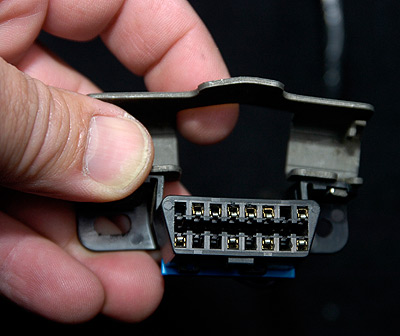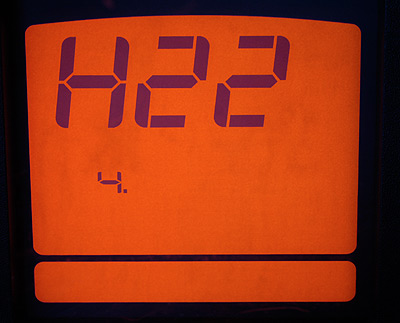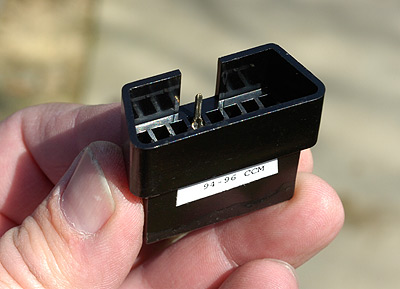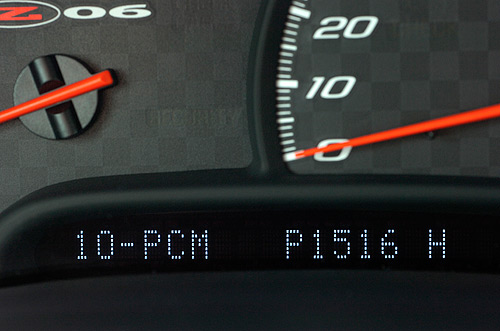A Dose of Digital: Part 1 - The Basics - Page 3 of 5
 |
 |
© 2010 by Hib Halverson
No use without permission, All Rights Reserved
![]() Discuss this article
Discuss this article
OBD

Click image for larger view
By MY82, Chevrolet already had two years of experience with on-board diagnostics such as on this '82 Collector Edition. That year, California passed the first laws mandating OBD. Interestingly, that law which went into effect in 1988 required a system which had some elements of what GM pioneered on the 1981 Vette and used until the mid-'90s.
Image: Author
It stands for "on-board diagnostics". Early in the design of engine controls, General Motors established that these controls must test themselves and, if trouble is found, advise the driver a problem exists, then upon command, reveal basic information about the nature of the trouble. This diagnostic ability was to be built into the vehicle, ie: it would be "on board", and work in parallel with the engine controls system. While the idea of on-board diagnostics might evoke a "well...duh!" today; in the early years, there were engine controls systems produced by other manufacturers which had minimal or no OBD.
In 1982, California codified on-board diagnostics (OBD), which, today, some call "generation one", requiring them on all, new, light-duty vehicles sold in that state starting in the 1988 model year (MY88). With OBD as far back as MY80, GM was well-positioned for compliance with the new law. Six years later, California passed more legislation mandating "on-board diagnostics, generation two" (OBD-II) as early as MY94 on some vehicles ('94 and '95 LT1s, for example) and, by MY96, on all new, light vehicles sold in the state. The Federal Clean Air Act Amendment of 1990 required on-board diagnostics, similar to California's OBD-II, for any light-duty vehicle sold in the country starting in MY96.
Four features made OBD-II systems different than OBD-I: 1) Not only were they required to detect and advise of trouble, but in some situations they were required advise that the engine's emissions were excessive, even if no engine controls component had yet failed. 2) OBD-II had to store information about conditions present when a problem occurred. 3) More engine functions were to be controlled and what was already controlled had to be done so more accurately. 4) Key parts of the system were standardized such as: a universal hardware connector (the "diagnostic link connector" or "DLC"), a common communications protocol, a standardized diagnostic trouble code numbering system and uniform terminology.
In the early-'90s, many in the performance aftermarket and enthusiast community were convinced OBD-II was going to be the kiss-of-death for hot rodders. While it certainly made powertrain modification more difficult (at least, if said powertrain was to remain "street legal"), in the end, the extreme nay-sayers (ok-I admit: in the early 90s, I was one of those nay-sayers) were wrong. While modification of OBD-II engines was more complex and DIY diagnosis and repair became more challenging, neither were impossible. In fact, certain aspects of OBD-II, mainly the standardization, proved a boon to the DIY.
Codes and Connecting
Fundamental to OBD is the diagnostic trouble code (DTC). When a Corvette's on board diagnostics detect a problem; they store data identifying that fault in the ECM's memory encoded in strings of either two or five digits. All '80-'95s store two-digit DTCs, '96-up stores five-digit codes and '94 and '95 LT1s can store some five-digit DTCs. In many cases, once the ECM stores a code, it, also, turns on a "check engine" or "service engine soon" (SES) warning light, known officially as a "malfunction indicator light" (MIL).
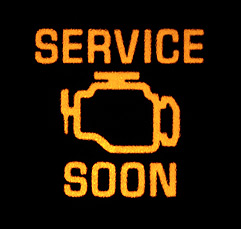 |
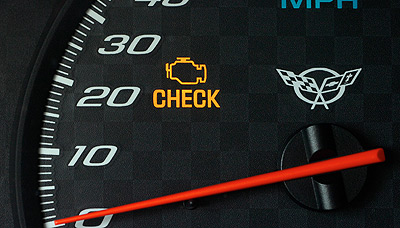 |
| In a C4, you'll see this warning indicator if the ECM has current codes set. Image: Author |
The MIL in a C5. Image: Author |
There are two varieties of codes, "current" or "hard," identifying faults existing at the time of the diagnostic session, and "history," or "soft," identifying faults which do not exist during the session but did exist at some time in the past 39, 79 or 99 ignition cycles, depending on model year and, if it's an OBD-II DTC, the code type. Generally, with OBD-I, history codes don't request the MIL but with OBD-II they may. Also, with OBD-II, certain non-emissions-related current DTCs will not turn on the MIL.
These connectors vary in shape, pin count and how pins are identified. '81s have 5-pin connectors, lettered, left-to-right. 1982-'93s and perhaps a few, early '94s have 12-pin DLCs, lettered top-left-to-bottom-right. Most '94 and all 1995-10 Vettes have 16-pin DLCs numbered top-left-to-bottom-right. C3s have their DLCs beneath the ash tray. C4s, -5s and -6es, have it beneath the instrument panel near the driver's knees.
All '81-'93s and '94-'95 ZR-1s support "flash code diagnostics". If you jump the DLC's "diagnostic" or "test" pin to either its ground pin or a chassis ground, then turn on the key, but don't start the engine (technicians say "key-up"); the MIL will flash codes. Test pins are: '81, pin C; '82-'93, pin B and '94-'95, Pin 6. Ground pins are: '81, Pin E, '82-'93, Pin A and '94-'95, Pin 4.
Once you enable flash code diagnostics, the MIL comes on for 4-seconds then blinks two digit DTCs. Each digit is signified by half-second-apart flashes. One second separates the digits. Codes flash three times with a 3-sec. pause between. If multiple codes exist, they'll display lowest to highest. Each code or code string is bracketed by code 12, signifying the sequence's start and end. If the MIL only flashes code 12, no DTCs are stored. If the MIL is on, but no codes are stored, see the Factory Service Manual for the model year of the car in question.
Say DTC22, a throttle position sensor fault, is present. The light flashes once, then twice (12), three times in succession. Next, it flashes twice, then twice (22), repeating that three times. Finally, it flashes code 12, again, three times in succession. It looks like this: 12-12-12-22-22-22-12-12-12. The sequence repeats until the jumper is removed.
The '90s-'95 ECMs support Central Control Module (CCM) diagnostics which enables them to display codes on their instrument panels. To enable the CCM diagnostic mode, with a '90-'93, jump DLC pin-G to pin-A or a chassis ground or, on '94 or '95, jump pin-12 to pin-4 or a chassis ground, then key-up. The IP will show fault codes where vehicle speed is normally and the module in which they are stored where the trip monitor is. The ECM is module four. The C4 IP cannot display five-digit DTCs so codes stored by '94-'95 partial OBD-II capability can only be read by a scan tester. MY96 is full OBD-II so CCM diagnostics for the ECM is not supported. The only way to get powertrain codes from a '96 is with a "scan tester" which we'll discuss later in this article. Extensive discussion of C4 CCM diagnostics is in Section 8D of the FSM for the model year in question, however, the MY96 book is in error stating that the ECM supports CCM diagnostics.
To make flash-code and CCM diagnostics work, you've got to jumper across DLC pins. In most C4s, it's tough to see the diagnostic connector well enough to count pins. Zip Products has the solution: grounding plugs which snap onto the DLC. We've used a set of these plugs '94-'96 (PN TL-163) and they are a great idea. You simply push one on the DLC, then key-up-way easier than fussing with jumper wires. A set of them (PN TL-162) is, also, available for '82-'93, 12-pin DLCs.
No C5 supports flash code diagnostics, but they do offer "on-board diagnostic display" which puts codes on the instrument panel cluster (IPC) display below the gauges. To put a '97-'04 in the "Automatic Display DTC" mode: 1) key-up 2) on the DIC button array, press "reset" to dismiss warning messages, 3) press and hold "options", then press the "fuel" button four times in five seconds. 5) release the buttons when the IPC begins to display codes in the automatic mode. It will show DTCs from any of the car's computers which send data. A more detailed discussion of this is in C5 FSMs in the "Instrument Panel, Gauges and Console" section.
Sadly, in spite of all the technology in the C6, it doesn't support on-board display of diagnostic trouble codes. General Motors' short-sighted decision to eliminate this feature is unfortunate for owners-but fortunate for dealers and independent repair shops. To read codes from a C6, you need a scan tester which supports the CAN protocol.
 |
 |
